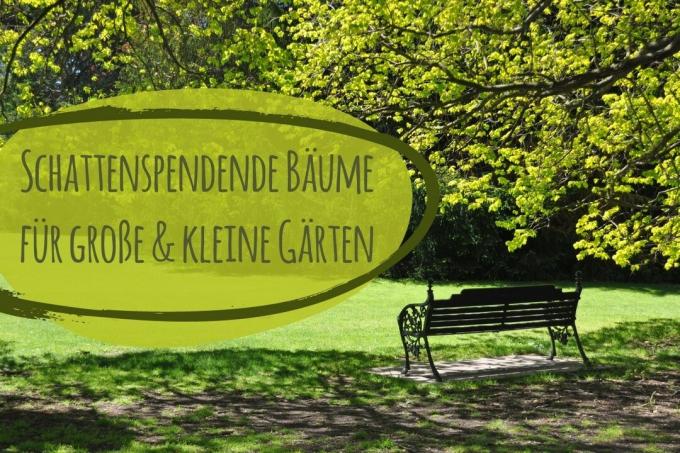
table of contents
- Shady trees for small gardens
- Shady trees for large gardens
- frequently asked Questions
Trees that provide shade should not be missing in any garden, which is why we present 44 great species for every garden and location - no matter whether small or large, sunny or shady.
In a nutshell
- for different locations and soils
- at different speeds in growth
- especially important: climatic trees that can cope with drought
- some species also for tub culture or for the front yard
Shady trees for small gardens
Even if you only have a small to medium-sized garden or yard, you don't have to do without trees that provide shade. The species presented here remain comparatively small, but form more lush crowns.
Sweet gum (Liquidambar styraciflua)

- Height: 8 to 20 meters
- Spread: 3 to 4 meters
- Growth rate: 40 to 60 centimeters / year
- Location: sunny to partially shaded
- Soil: rich in nutrients
- Special features: bright red autumn colors
Common whitebeam (Sorbus aria)

- Height: 6 to 18 meters
- Spread: 4 to 12 meters
- Growth rate: 25 to 35 centimeters / year
- Location: sunny to partially shaded
- Soil: undemanding, permeable
- Special features: bees and birds nourishing wood, city climate-proof
Fire maple (Acer ginnala)

- Height: 5 to 6 meters
- Spread: up to 7 meters
- Growth rate: 35 to 40 centimeters / year
- Location: sunny to shady
- Soil: rich in nutrients, does not tolerate lime
- Special features: tolerates drought, fiery red autumn color
Common Judas Tree (Cercis siliquastrum)

- Height: up to 6 meters
- Spread: up to 4 meters
- Growth rate: 25 to 50 centimeters / year
- Location: sunny to partially shaded
- Soil: normal garden soil
- Special features: ornamental flowering trees, well suited for dry soils
Common bird cherry (Prunus padus)

- Height: up to 15 meters
- Spread: up to 7 meters
- Growth rate: 40 to 70 centimeters / year
- Location: sunny to partially shaded
- Soil: undemanding
- Special features: valuable wood for birds
Himalayan birch (Betula utilis)
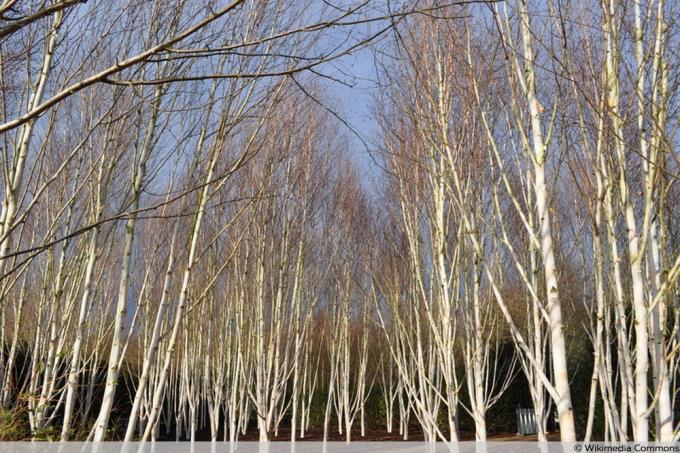
- Height: 8 to 15 meters
- Spread: 5 to 7 meters
- Growth rate: 20 to 30 centimeters / year
- Location: sunny to partially shaded
- Soil: normal garden soil
- Special features: the trunk is extremely white
Note: The Himalayan birch originally comes from the Himalayas and is mainly at home in Kashmir and Nepal. It impresses with its brilliant white bark and its extreme hardiness.
Canadian Judas Tree (Cercis canadensis)

- Height: 5 to 8 meters
- Spread: up to 8 meters
- Growth rate: 20 to 40 centimeters / year
- Location: sunny to partially shaded
- Soil: normal garden soil
- Special features: suitable for pots and front gardens
Tip: The cultivar 'Forest Pansy' is particularly well-suited, as it is extremely frost-hardy after it has survived its youth and also impresses with its beautiful, red foliage.
Cake tree (Cercidiphyllum japonicum)
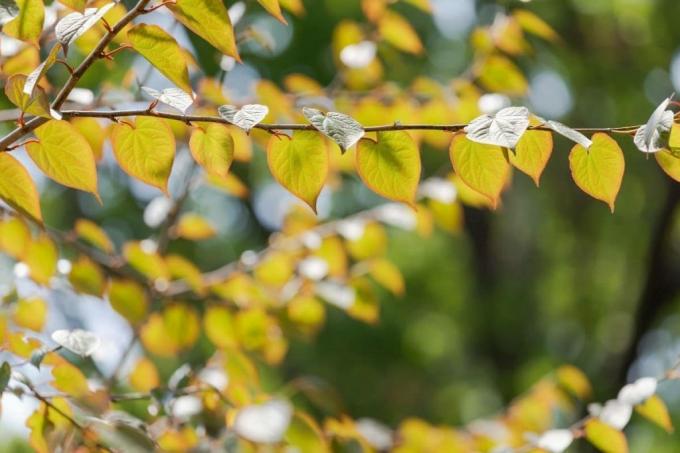
- Height: 8 to 10 meters
- Spread: up to 7 meters
- Growth rate: 30 to 50 centimeters / year
- Location: sunny to partially shaded
- Soil: nutrient-rich, loamy to clayey
- Special features: bright autumn colors
Note: The cake tree is also sold under the name Katsura tree or (Japanese) gingerbread tree, as its leaves give off a scent of gingerbread.
Ball trumpet tree 'Nana' (Catalpa bignonioides 'Nana')

- Height: 4 to 7 meters
- Spread: 4 to 7 meters
- Growth rate: 20 to 30 centimeters / year
- Location: sunny to partially shaded
- Soil: normal garden soil
- Special features: dense, spherical crown
Tip: The decorative ball trumpet tree is unfortunately quite temperature-sensitive and therefore absolutely needs a sheltered place in the garden and frost protection in winter.
Cultivated apple (Malus domestica)

- Height: up to 10 meters
- Spread: up to 5 meters
- Growth rate: 20 to 40 centimeters / year
- Location: sunny to partially shaded
- Soil: normal garden soil, well drained
- Special features: edible fruits
Note: There are hundreds of different apple varieties with different fruits, ripening times and growth forms.
Cultivated pear (Pyrus communis)

- Height: 5 to 15 meters
- Spread: 3 to 6 meters
- Growth rate: 30 to 60 centimeters / year
- Location: sunny to partially shaded
- Soil: undemanding
- Special features: edible fruits
Persian ironwood tree (Parrotia persica)
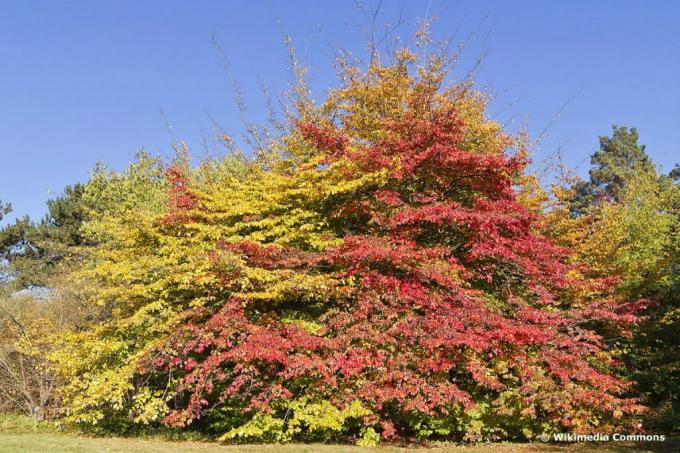
- Height: up to 9 meters
- Spread: up to 7 meters
- Growth rate: 20 to 40 centimeters / year
- Location: sunny to partially shaded
- Soil: normal garden soil, adaptable
- Special features: shallow roots, therefore do not underplant
Note: The ironwood tree has its name for a reason, because its wood is not buoyant due to its extreme density.
Sour cherry (Prunus cerasus)

- Height: up to approx. 6 meters
- Spread: up to approx. 4 meters
- Growth rate: 30 to 50 centimeters / year
- Location: sunny to shady
- Soil: normal garden soil
- Special features: undemanding fruit tree with edible fruits, numerous varieties
Handkerchief tree / pigeon tree (Davidia involucrata)
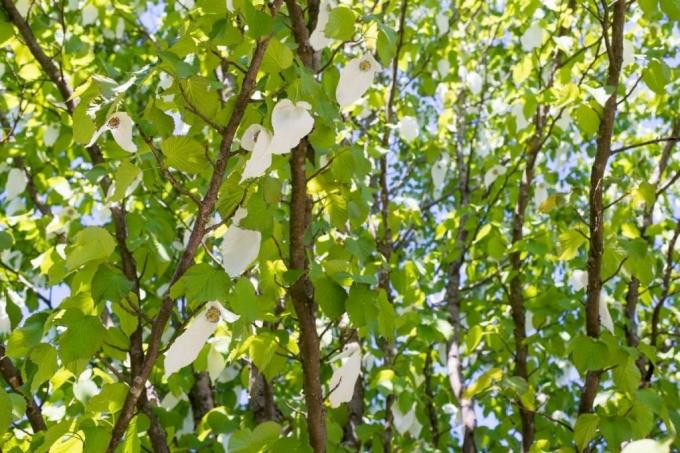
- Height: 6 to 8 meters
- Spread: up to 4.5 meters
- Growth rate: 20 to 40 centimeters / year
- Location: sunny to partially shaded
- Soil: normal garden soil
- Special features: attractive blossom tree with eye-catching bracts
Rowan / Mountain Ash (Sorbus aucuparia)

- Height: 6 to 12 meters
- Spread: 4 to 6 meters
- Growth rate: 30 to 70 centimeters / year
- Location: sunny to partially shaded
- Soil: loose, humic, fresh to moist
- Special features: valuable wood for birds, bright red fruits
Shady trees for large gardens
There is a huge selection of shady trees for large gardens or even parks.
American Gleditschia / Lederhülsenbaum (Gleditsia triacanthos)
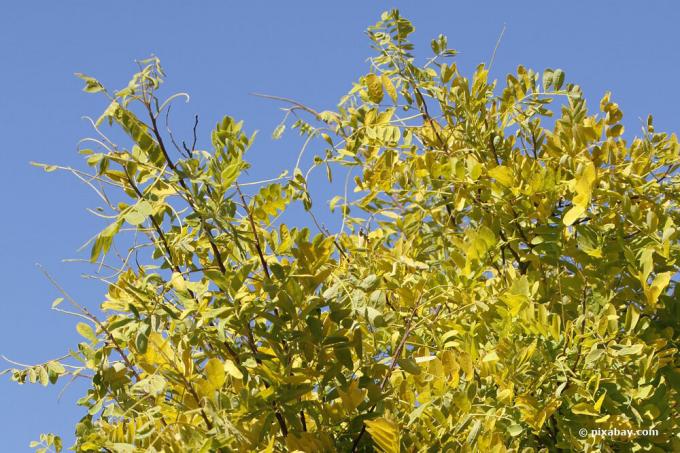
- Height: 15 to 20 meters
- Spread: 8 to 20 meters
- Location: sunny
- Soil: nutrient-rich, fresh to moist
- Special features: climatic tree, strongly scented flower clusters from June to July
American red oak (Quercus rubra)
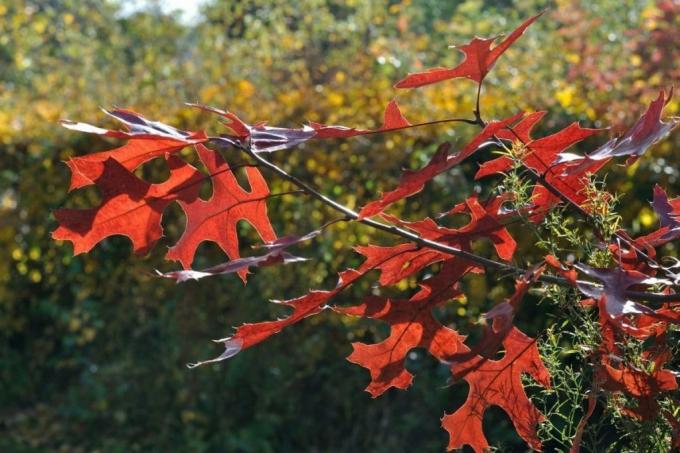
- Height: 20 to 25 meters
- Spread: 10 to 15 meters
- Growth rate: 55 centimeters / year
- Location: sunny
- Soil: undemanding
- Special features: urban climate-proof, fast-growing
Tree hazel (Corylus colurna)

- Height: 12 to 20 meters
- Spread: 8 to 12 meters
- Growth rate: 20 to 35 centimeters / year
- Location: sunny to partially shaded
- Soil: deep, loamy
- Special features: broad, conical crown, edible nuts
Sycamore maple (Acer pseudoplatanus)

- Height: 25 to 30 meters
- Spread: 15 to 20 meters
- Growth rate: 10 to 100 centimeters / year
- Location: sunny to partially shaded
- Soil: fresh to moist, calcareous
- Special features: bird nursery wood, extremely hardy
Mountain elm (Ulmus glabra)

- Height: up to 35 meters
- Spread: up to 20 meters
- Growth rate: 40 to 60 centimeters / year
- Location: sunny to partially shaded
- Soil: rich in nutrients, deep
- Special features: developed particularly, broad crown
Tip: Mountain elms feel particularly at home in a location along a flowing body of water.
Bluebell tree (Paulownia tomentosa)

- Height: up to 15 meters
- Spread: up to 10 meters
- Growth rate: 40 to 50 centimeters / year
- Location: sunny
- Soil: well-drained, moderately dry to fresh
- Special features: large purple flower panicles from April to May
Note: The bluebell tree enchants not only with its magnificent flowers, but also with its large, velvety, hairy and heart-shaped leaves.
German oak / English oak (Quercus robur)
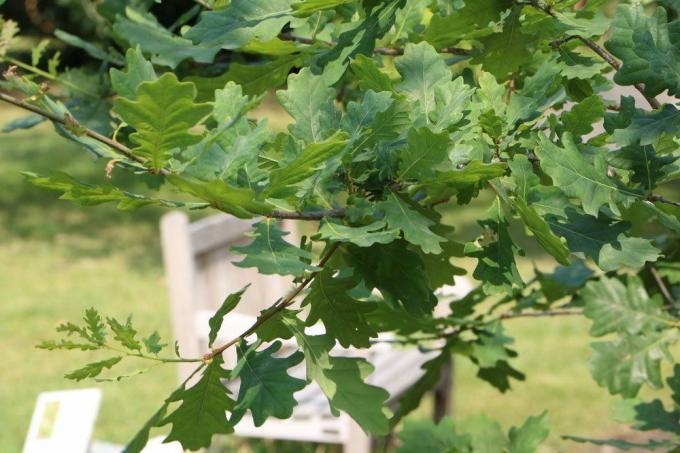
- Height: up to 35 meters
- Spread: up to 20 meters
- Growth rate: 25 to 50 centimeters / year
- Location: sunny to partially shaded
- Soil: rich in nutrients, deep
- Special features: tolerates dry conditions, native species
Fan leaf tree / Ginkgo tree (Ginkgo biloba)
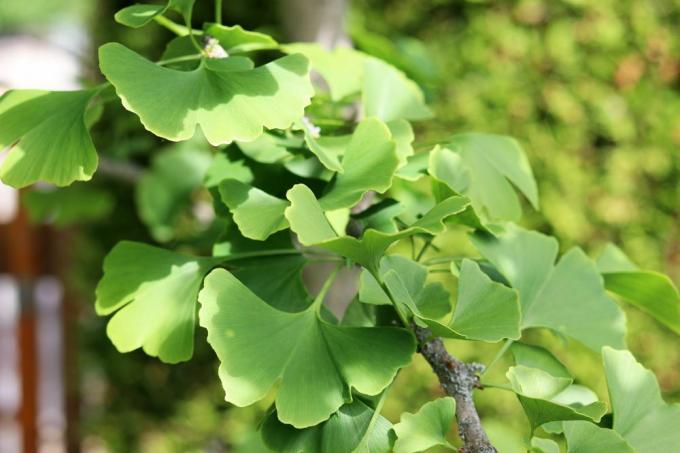
- Height: up to 20 meters
- Spread: up to 10 meters
- Growth rate: 30 to 50 centimeters / year
- Location: sunny to partially shaded
- Soil: normal garden soil
- Special features: undemanding, no known diseases
Note: The ginkgo tree, which originally came from China, is one of the oldest tree species on earth: it grew 180 million years ago when dinosaurs still populated the earth.
Field elm (Ulmus carpinifolia)

- Height: 15 to 30 meters
- Spread: 15 to 25 meters
- Growth rate: 30 to 60 centimeters / year
- Location: sunny to partially shaded
- Soil: nutrient-rich, lime-loving, not too dry
- Special features: urban climate and industry-friendly, warmth-loving, native species
European white elm (Ulmus laevis)
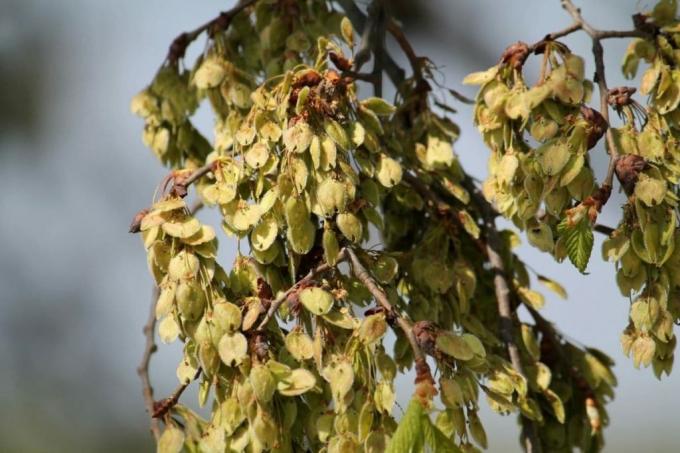
- Height: up to 40 meters
- Spread: up to 20 meters
- Location: sunny to partially shaded
- Soil: nutrient-rich, lime-loving, fresh to wet
- Special features: urban climate-proof, hardly affected by the Dutch elm disease
Common ash (Fraxinus excelsior)

- Height: up to 25 meters
- Spread: up to 20 meters
- Growth rate: 30 to 45 centimeters / year
- Location: sunny to partially shaded
- Soil: nutrient-rich, moist
- Special features: native species, ideal for ponds or brooks
Green beech 'Pendula' (Fagus sylvatica 'Pendula')

- Height: 15 to 30 meters
- Spread: 20 to 25 meters
- Growth rate: 25 to 40 centimeters / year
- Location: sunny to shady
- Soil: rich in nutrients, chalky, fresh to moist
- Special features: deep overhanging branches, becomes very stately with age
Tip: With its dark red foliage, the attractive variety of black and red hanging beech (Fagus sylvatica 'Purpurea Pendula') is particularly eye-catching.
Hornbeam / White Beech (Carpinus betulus)

- Height: up to 15 meters
- Spread: up to 8 meters
- Growth rate: 20 to 75 centimeters / year
- Location: sunny to partially shaded
- Soil: undemanding, even for drier soils
- Special features: cut-resistant, also suitable for hedges
Hop beech (Ostrya carpinifolia)

- Height: 10 to 15 meters
- Spread: 8 to 13 meters
- Growth rate: 20 to 45 centimeters / year
- Location: sunny to shady
- Soil: dry to fresh, rich in nutrients
- Special features: climatic tree, for lime-rich soils
Japanese pagoda tree (Sophora japonica)
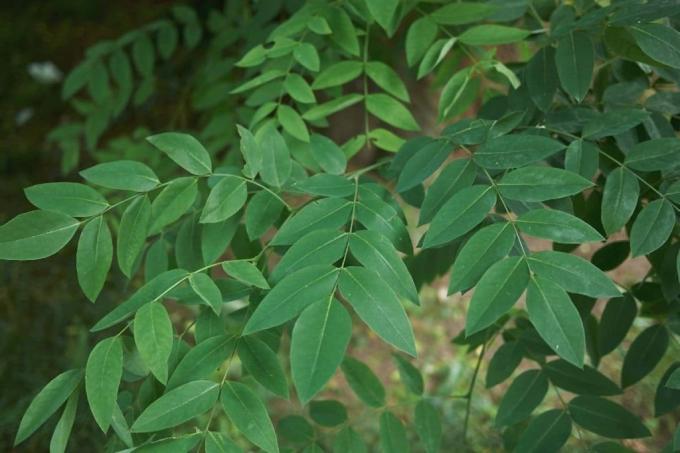
- Height: 15 to 20 meters
- Spread: 10 to 18 meters
- Growth rate: 20 to 45 centimeters / year
- Location: sunny
- Soil: rich in nutrients, deep
- Special features: good wood for bees, climatic tree
Plane tree (platanus hispanica)

- Height: 25 to 30 meters
- Spread: 15 to 20 meters
- Growth rate: 45 to 60 centimeters / year
- Location: sunny to shady
- Soil: rich in nutrients, deep, fresh to moist
- Special features: easy to cut, suitable for urban climates
Purple Alder (Alnus spaethii)

- Height: 12 to 18 meters
- Spread: 6 to 8 meters
- Growth rate: 30 to 50 centimeters / year
- Location: sunny to partially shaded
- Soil: undemanding
- Special features: climate tree, city climate-proof, hybrid breeding
Horse chestnut (Aesculus hippocastanum)
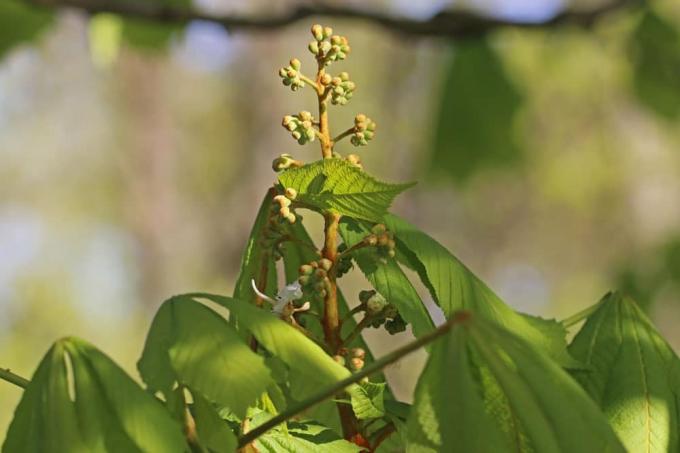
- Height: 25 to 30 meters
- Spread: up to 20 meters
- Growth rate: 45 to 50 centimeters / year
- Location: sunny to partially shaded
- Soil: fresh, profound
- Special features: showy, very large leaves, fruits in autumn
Red maple (Acer rubrum)

- Height: 10 to 15 meters
- Spread: 6 to 10 meters
- Growth rate: 15 to 40 centimeters / year
- Location: sunny
- Soil: grows almost everywhere, with as little lime as possible
- Special features: impressive autumn color, tolerates drought
Common beech (Fagus sylvatica)

- Height: up to 30 meters
- Spread: 6 to 8 meters
- Growth rate: 20 to 50 centimeters / year
- Location: sunny to shady
- Soil: nutrient-rich, fresh to moist
- Special features: native species
Tip: The European beech is very easy on pruning and can therefore be grown well as a (high) hedge.
Red Alder (Alnus glutinosa)

- Height: 10 to 30 meters
- Spread: 8 to 12 meters
- Growth rate: 30 to 50 centimeters / year
- Location: sunny to partially shaded
- Soil: moist to wet
- Special features: valuable for birds and insects
White willow (Salix alba)
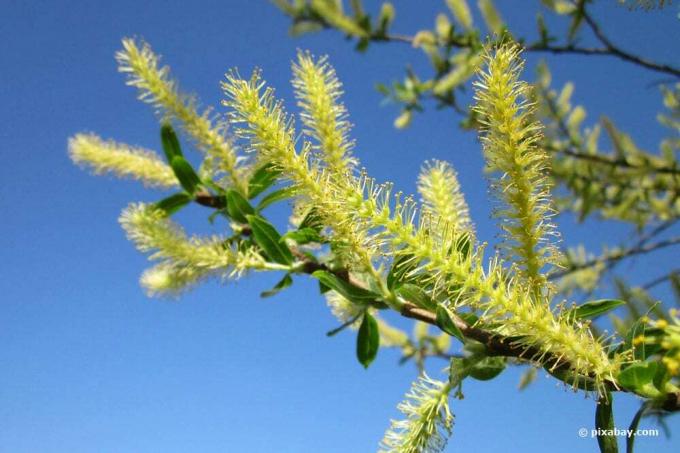
- Height: 15 to 20 meters
- Spread: 10 to 15 meters
- Growth rate: 60 to 150 centimeters / year
- Location: sunny to partially shaded
- Soil: rich in nutrients, preferably moist to wet
- Special features: ideal for ponds or brooks, also tolerates drier soils
Note: The white willow is also known under the name "polluted willow".
Summer linden (Tilia platyphyllos)

- Height: up to 35 meters
- Spread: up to 25 meters
- Growth rate: 40 to 60 centimeters / year
- Location: sunny
- Soil: deep, rich in nutrients
- Special features: valuable wood for bees
Sweet cherry (Prunus avium)
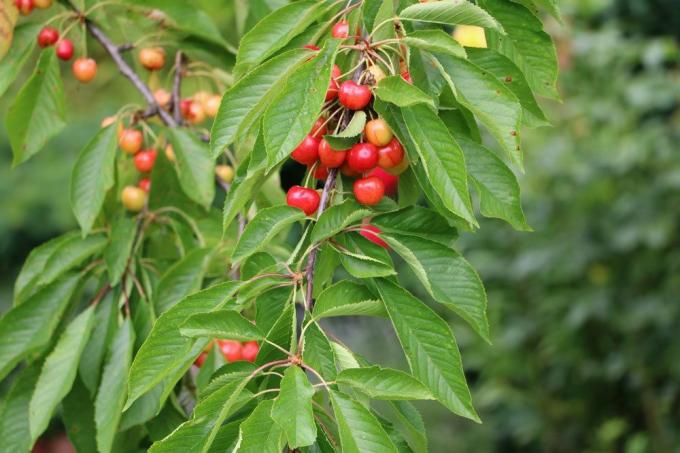
- Height: up to 20 meters
- Spread: up to 15 meters
- Growth rate: 40 to 60 centimeters / year
- Location: sunny
- Soil: deep, permeable
- Special features: numerous varieties with edible fruits
Tip: There are hundreds of cultivars of the sweet cherry, many of which remain significantly smaller than the original species and are therefore also suitable for smaller gardens.
Trumpet Tree (Catalpa bignonioides)

- Height: up to 15 meters
- Spread: up to 10 meters
- Growth rate: 30 to 50 centimeters / year
- Location: sunny to partially shaded
- Soil: nutrient-rich, fresh
- Special features: ornamental tree
Tip: The 'Nana' variety with a spherical crown is recommended for small gardens.
Tulip tree (Liriodendron tulipifera)

- Height: 20 to 35 meters
- Spread: 12 to 20 meters
- Growth rate: 30 to 70 centimeters / year
- Location: sunny to partially shaded
- Soil: nutrient-rich, fresh to moist
- Special features: tulip-like flowers from May to June
Walnut (Juglans regia)
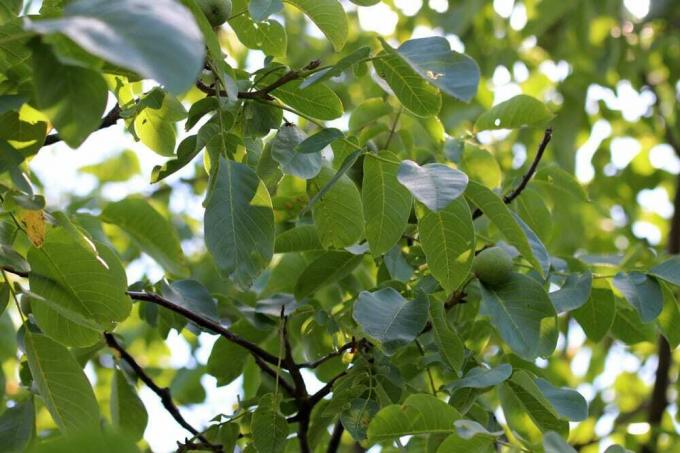
- Height: 15 to 20 meters
- Spread: 10 to 15 meters
- Growth rate: 40 to 50 centimeters / year
- Location: sunny to partially shaded
- Soil: normal garden soil
- Special features: edible nuts in autumn
White birch (Betula pendula)
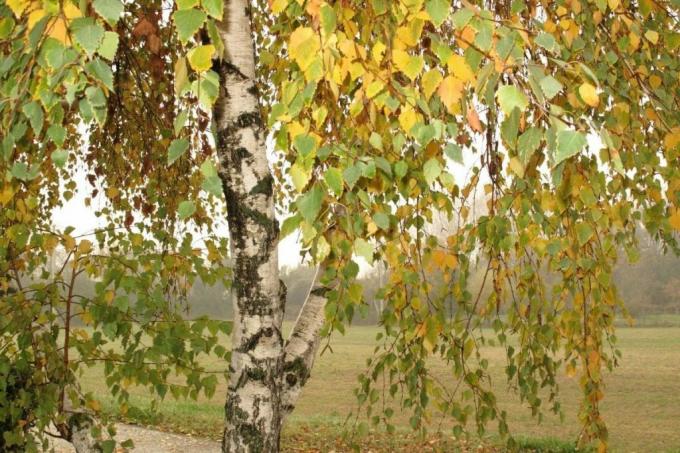
- Height: up to 20 meters
- Spread: up to 10 meters
- Growth rate: 30 to 45 centimeters / year
- Location: sunny
- Soil: undemanding
- Special features: grows almost everywhere
Tip: The native species is also known as sand birch or silver birch. It can cope with almost any type of soil and can tolerate drought.
Winter linden (Tilia cordata)

- Height: up to 30 meters
- Spread: 10 to 15 meters
- Growth rate: 25 to 50 centimeters / year
- Location: sunny to partially shaded
- Soil: deep, rich in nutrients
- Special features: valuable wood for bees
frequently asked Questions
Since the effects of climate change are becoming more and more noticeable in Germany, you should increasingly rely on plants that can cope well with drought. Trees that provide shade for the garden, which have been tried and tested as climatic trees, are primarily elms, purple alder, gleditschia, hop beech and pagoda.
All beech and maple species are particularly undemanding in terms of their light requirements, which is why they can also be planted in places with little light in the garden. Linden trees also thrive in partial shade - and as shady trees, for example, they still do a good job at the afternoon coffee table outdoors.
Trees that provide shade, which are also particularly fast-growing, are above all: the bluebell tree, the trumpet tree and all types of maple. Red beech, birch, ash, willow and poplar also grow comparatively quickly. In addition, it is not only trees that provide shade that grow better if they are in an optimal location and are well cared for.



